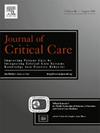脓毒症危重患者早期能量输送和28天死亡率:一项多中心集群随机对照试验的事后分析
IF 2.9
3区 医学
Q2 CRITICAL CARE MEDICINE
引用次数: 0
摘要
背景:脓毒症仍然是重症监护病房(ICU)死亡的主要原因,但最佳的能量输送策略尚不清楚。本事后分析探讨了ICU脓毒症患者早期能量输送与28天全因死亡率之间的关系。方法:这项多中心NEED试验(ISRCTN12233792)的事后分析纳入了脓毒症且住院≥7天的ICU患者。早期能量输送(前7天)按目标25千卡/公斤理想体重的百分比计算。结果:该分析纳入1162例败血症患者(中位年龄66.0岁,66.3%为男性),其中183例(15.7%)患者在ICU入院后28天内死亡。低危患者的最佳能量输送阈值为100%,高危患者为60%。Cox比例风险模型进一步证实,在高危组中,达到≥60%的目标与较低的28天死亡风险相关(风险比= 0.588,95%可信区间:0.388-0.891),而在低危组中未观察到获益。此外,在亚组分析中没有发现显著的相互作用。限制三次样条分析表明,随着能量输送的增加,高危患者的死亡风险呈下降趋势(p非线性= 0.063)。结论:早期能量输送≥60%的目标与高危脓毒症患者28天死亡率降低有关,低危组无明显获益。这些结果支持败血症护理中基于风险的营养策略。试验注册:ISRCTN 12233792,于2017年11月24日注册。本文章由计算机程序翻译,如有差异,请以英文原文为准。
Early energy delivery and 28-day mortality in critically ill patients with sepsis: Post hoc analysis of a multicenter cluster-randomised controlled trial
Background
Sepsis remains a leading cause of mortality in intensive care units (ICU), but optimal energy delivery strategies remain unclear. This post hoc analysis examines the association between early energy delivery and 28-day all-cause mortality in ICU patients with sepsis.
Methods
This post hoc analysis of the multicentre NEED trial (ISRCTN12233792) included ICU patients with sepsis and ≥ 7-day stays. Early energy delivery (first 7 days) was calculated as a percentage of the target 25 kcal/kg ideal body weight. Patients were stratified by mNUTRIC score (<5 vs ≥5). Associations with 28-day mortality were assessed using Cox models and Kaplan-Meier analysis, with subgroup and spline analyses exploring effect modification and nonlinearity.
Results
This analysis included 1162 sepsis patients (median age 66.0 years, 66.3 % male), with 183 (15.7 %) patients deceased within 28-day after ICU admission. The optimal energy delivery thresholds were identified as 100 % of the target for low-risk and 60 % for high-risk patients. Cox proportional hazards models further confirmed that in the high-risk group, achieving≥60 % of the target was associated with a lower 28-day mortality risk (hazard ratio = 0.588, 95 % conficence interval: 0.388–0.891), whereas no benefit was observed in low-risk patients. Additionally, no significant interactions were found in subgroup analyses. Restricted cubic spline analysis suggested a downward trend in mortality risk with increasing energy delivery in high-risk patients (P-nonlinear = 0.063).
Conclusions
Early energy delivery ≥60 % of target is linked to lower 28-day mortality in high-risk sepsis patients, with no clear benefit in low-risk groups. These results support risk-based nutritional strategies in sepsis care.
Trials registration: ISRCTN 12233792, registered on November 24, 2017.
求助全文
通过发布文献求助,成功后即可免费获取论文全文。
去求助
来源期刊

Journal of critical care
医学-危重病医学
CiteScore
8.60
自引率
2.70%
发文量
237
审稿时长
23 days
期刊介绍:
The Journal of Critical Care, the official publication of the World Federation of Societies of Intensive and Critical Care Medicine (WFSICCM), is a leading international, peer-reviewed journal providing original research, review articles, tutorials, and invited articles for physicians and allied health professionals involved in treating the critically ill. The Journal aims to improve patient care by furthering understanding of health systems research and its integration into clinical practice.
The Journal will include articles which discuss:
All aspects of health services research in critical care
System based practice in anesthesiology, perioperative and critical care medicine
The interface between anesthesiology, critical care medicine and pain
Integrating intraoperative management in preparation for postoperative critical care management and recovery
Optimizing patient management, i.e., exploring the interface between evidence-based principles or clinical insight into management and care of complex patients
The team approach in the OR and ICU
System-based research
Medical ethics
Technology in medicine
Seminars discussing current, state of the art, and sometimes controversial topics in anesthesiology, critical care medicine, and professional education
Residency Education.
 求助内容:
求助内容: 应助结果提醒方式:
应助结果提醒方式:


